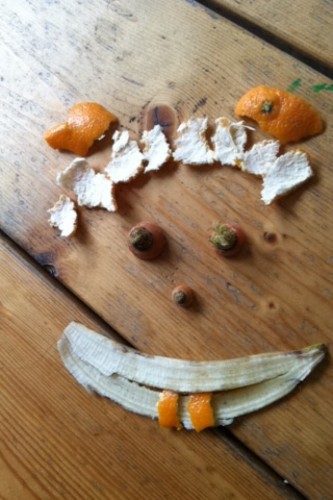Dear Reader: Before you embark on this adventure, may I recommend some easy listening? https://www.youtube.com/watch?v=oc-P8oDuS0Q
This morning Abby, Gina, Katherine and I reluctantly returned to Loeffler’s Corner again to harvest heads. I say reluctantly because the last time this quad ventured to Loeffler’s it was to do demography rechecks. And that ended with us in the back of Abby’s car consoling our somewhat broken spirits with unroasted s’mores. However today with renewed spirits, we harvested with the vim and vigor of girls with clear hearts. In harvesting heads we knew we must take off everything, leaving nary a twist-tie in our wake. This ensures that heads can be uniquely identified, throughout the sorting process.
No longer beaten-down by Loeffler’s, we were far too young and clever to be confused by metal tags and dud flowers- no not us! Before getting in the van we cried too-ra-loo-ra, too-ra-loo-rye aye as we drove back to Hjelm house.
By the time we got back to Hjlem, Stuart had returned from his sojourn in Chicago! No longer do we wear beaten-down eyes sunk in smoke-dried faces, we were so happy to be reunited with Stuart. Abby could barely hold back a too-ra-loo-ra, too-ra-loo-rye aye she was so overjoyed, and Gina sang along and said she would surely hum this tune forever when she remembered the reunion. Who’d blame them for being glad, things round here have changed since Stuart’s been back and now we will have plenty of demo rechecks to do tomorrow!
The rest of the team spent the morning doing demo rechecks at Riley and East Riley, and sorting various harvest maps. They replaced many red twist-ties, because the red ties we put on plants at the beginning of the summer had lost their color and the poor old ties looked more clear than red! With each twist-tie added, members of Team Echinacea felt like they were putting pretty red dresses on the flowering plants.
At lunch, Gina talked about her findings from the aphid project. As Gina explained the statistics behind her analysis, I confess, I thought to myself: “Aah these things, I know they are real, but I swear what [s]he means could be said in plain english.” Stuart taught us how to explain our statistical results in language that is accessible to a broader audience, a valuable lesson for all scientists! Gina and Abby studied the same plants that were used in the 2012 aphid research and since then the plants have grown, so grown, and I must say now more than ever that there are more flowering than there were in the original data-set. To look at how more flowering plants may affect the data, the girls must come on out to P1 and assess herbivory on the cauline leaves. They were so resigned to what their fate was that they went straight to P1 after lunch to look at the leaves. These people round here really know how to tell a story of plant/insect interactions that captures the changes that occur in Echinacea populations over time.
After lunch, Katherine and I headed out to P1 to repaint Echinacea used in Q3 all the while humming Jonny Ray. Although his voice sounded sad on the radio, we can sing [his music] just like our fathers and that small comfort motivated us to do the best we could with the painting.
The Echinacea Project has taught me so much about teamwork, and at this moment, I remember that Katherine’s help means everything to me. You feel as if you can do the work alone, but when your hair verges on dirty, and you have shown weakness in the afternoon heat, it is your partner who will make you feel like saying too-ra-loo-ra, too-ra-loo-rye aye!
I look forward to the days when the Echinacea Project’s papers are as popular as Dexy’s Midnight Runners, a band who moved a million albums in mono. In the mean time, we spend our time fighting off hornets here at Hjelm House, unrecognized heros in the world of evolutionary ecology.

